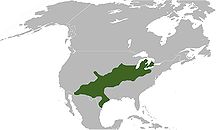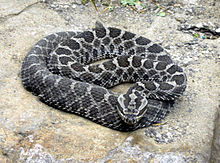Eastern massasauga
| Eastern massasauga | |
|---|---|

| |
| Scientific classification | |
| Domain: | Eukaryota |
| Kingdom: | Animalia |
| Phylum: | Chordata |
| Class: | Reptilia |
| Order: | Squamata |
| Suborder: | Serpentes |
| Family: | Viperidae |
| Genus: | Sistrurus |
| Species: | S. catenatus
|
| Binomial name | |
| Sistrurus catenatus (Rafinesque,1818)
| |

| |
| Range in green (when includingS. tergeminus) | |
| Synonyms[3] | |
| |
Theeastern massasauga(Sistrurus catenatus) is arattlesnakespecies found in central and easternNorth Americafrom southernOntarioinCanadaand throughout theMidwesternandEasternUnited States. Like all rattlesnakes, it is apit viperand isvenomous;it is the only species of venomous snake in Ontario.[4]
Taxonomy[edit]
Threesubspecieswere recognized for more than a century,[5]although research published in 2011 elevated two subspeciesSistrurus catenatus catenatusandSistrurus catenatus tergeminus,to full species: the eastern massasauga (Sistrurus catenatus) and thewestern massasauga(Sistrurus tergeminus).[6]The status of the third subspecies was somewhat unresolved and it is tentatively recognized as the desert massasauga (Sistrurus tergeminus edwardsii) by some,[7]or synonymized with the western massasauga (Sistrurus tergeminus) by others.[8]It is currently thought that eastern massassauga ismonotypic;i.e. has no recognized subspecies.[2]
Description[edit]

Adults ofS. catenatusare not large, ranging from 60 to 75 cm (24 to 30 in) in length.[9]Their color pattern consists of a grey or tan ground color with a row of large, rounded, brown/black blotches or spots down the center of the back and three smaller rows of alternating spots down each side. Solid blackmelanisticexamples are also known, as well as cases where the back blotches join with those on the sides. Young massasaugas are well-patterned, but paler than the adults. They have heat-sensing pits on each side of their smallish heads, their scales are keeled, and their anal scales are single.
Common names[edit]
Common names of the massasauga include: massasauga rattlesnake, massasauga rattler (Ontario), black massasauga, black rattler, black snapper, gray rattlesnake (Iowa), little grey rattlesnake (Canada), muck rattler, prairie rattlesnake, spotted rattler, swamp rattler, dwarf prairie rattlesnake, eastern massasauga great adder, ground rattlesnake, Kirtland's rattlesnake, little black rattlesnake, Michigan point rattler (Michigan), prairie massasauga, rattlesnake, small prairie rattlesnake, snapper, swamp massasauga, swamp rattlesnake, and triple-spotted rattlesnake.[10][11]
TheNative Americanword, "massasauga", means "great river-mouth" in theOjibwe languageand was probably given to describegrasslandssurrounding theriver deltasinOjibwecountry.[12]
Distribution[edit]
S. catenatusis found in North America from Ontario, Canada and central and westernNew Yorkthroughout theGreat Lakes regionto the Midwest. It occurs in various habitats ranging from swamps and marshes to grasslands, usually below 1,500 m (4,900 ft) elevation. Thetype localitygiven is "...on the prairies of the upper Missouri "(Valley, US).[3]
Conservation status[edit]
ThespeciesS. catenatusis classified asleast concernon theIUCNRed List of Threatened Species.The population trend is unknown.[1]The eastern massasauga has been listed as a candidate species on the United States Endangered Species Act since 1999.[13]
The eastern massasauga is listed as anendangered speciesinIllinois,Indiana,Iowa,Minnesota,Missouri(also consideredextirpated), New York,Ohio,Pennsylvania,andWisconsin.[14][15][16]Michigan, the only state in which it is not considered endangered, lists it as "special concern".[17]The subspecies is a candidate for federal listing.[18]As of 2016, the massasauga is listed as Threatened under theEndangered Species Act.[19]
The eastern massasauga is listed as threatened under both Ontario's Endangered Species Act, 2007, and the federalSpecies at Risk Act,and is protected under the Fish and Wildlife Conservation Act.[9][20]It is found only near the eastern shore ofGeorgian Bay,theBruce Peninsula,theNorth ShoreofLake Huron,[21]Wainfleet Bog, and Ojibway Prairie.[22]It is becoming rare in Canada due to persecution and loss of habitat and is designated as "threatened" by the Committee on the Status of Endangered Wildlife in Canada (COSEWIC),[23]as well as the Committee on the Status of Species-at-risk in Ontario (COSSARO).
In Pennsylvania, the species has experienced a rapid decline largely because ofhabitat loss.Historically, this has been due to human activity and more recently primarily from natural forest succession. By 1988, the snake had disappeared from half of the counties that constituted its historical range.[24]A 2003–2005 survey showed only four locations in two counties with confirmed populations.[25]It is classified as "critically imperiled" to "imperiled" in thecommonwealth.[26]
Diet[edit]
The diet ofS. catenatusconsists of a variety of smallvertebrates,includingmammals,birds,birdeggs,[27]lizards,and other snakes, as well asinvertebratessuch ascentipedesandinsects.[27]Mammals andreptilesmake up the bulk of their diet. Adults feed mainly onrodents(such asvoles,white-footed mice,jumping mice,andshrews),[27]while juveniles usually prey on reptiles, more often lizards in western populations and snakes in eastern ones. Frogs also constitute an important part of their diet:Ruthven(1928) mentioned that in Michigan they made up the main portion of their diet. According toKlauber(1956),S. catenatusfeeds on frogs more frequently than any other rattlesnake. In general, however,frogsare not an important part of the diet, although this does seem to be more typical in certain northern and eastern populations.[10]
Venom[edit]
ThevenomofS. catenatusis acytotoxicvenom, so it destroys tissue. It also contains specialized digestive enzymes that disrupt blood flow and prevent blood clotting. Severe internal bleeding causes the death of the small animals that this snake eats. After envenomation, the rattlesnake is able to withdraw from the dangers of sharp-toothed prey animals until they are subdued and even partially digested by the action of the venom.
S. catenatusis rather shy and avoids humans when it can. Most massasauga snakebites in Ontario have occurred after people deliberately handled or accidentally stepped on one of these animals.[citation needed]Both of these scenarios can be prevented by avoiding hiking through areas of low visibility (in rattlesnake country) when not wearing shoes and long pants and by leaving the snakes alone if encountered. Only two incidents of people dying from massasauga rattlesnake bites in Ontario have been recorded; in both cases, the victims did not receive proper treatment.[28]
References[edit]
- ^abFrost, D.R.; Hammerson, G.A.; Santos-Barrera, G. (2007)."Sistrurus catenatus".IUCN Red List of Threatened Species.2007:e.T64346A12772707.doi:10.2305/IUCN.UK.2007.RLTS.T64346A12772707.en.Retrieved19 November2021.
- ^ab"Sistrurus catenatus.NatureServe Explorer 2.0 ".explorer.natureserve.org.Retrieved2023-03-24.
- ^abMcDiarmid RW, Campbell JA, Touré T. (1999).Snake Species of the World: A Taxonomic and Geographic Reference, vol. 1.Herpetologists' League. 511 pp.ISBN1-893777-00-6(series).ISBN1-893777-01-4(volume).
- ^"Massasuga Rattlesnake".Nature Conservancy of Canada.
- ^"Sistrurus catenatus".Integrated Taxonomic Information System.Retrieved30 January2007.
- ^Kubatko, Laura S.; Gibbs, H. Lisle; Bloomquist, Erik W. (2011). "Inferring species-level phylogenies and taxonomic distinctiveness using multilocus data inSistrurusrattlesnakes ".Systematic Biology.60(4): 393–409.doi:10.1093/sysbio/syr011.
- ^Powell, Robert, Roger Conant, and Joseph T. Collins. 2016.Peterson Field Guide to Reptiles and Amphibians of Eastern and Central North America, 4rd ed.Houghton Mifflin Co., Boston, Massachusetts. xiii, 494 pp. (see pages 443-445)ISBN978-0-544-12997-9
- ^Sistrurus tergeminusat theReptarium.cz Reptile Database.Accessed April 12, 2022.
- ^abEastern Massasauga,Ontario Nature
- ^abCampbell JA, Lamar WW. (2004).The Venomous Reptiles of the Western Hemisphere.Comstock Publishing Associates, Ithaca and London. 870 pp. 1500 plates.ISBN0-8014-4141-2.
- ^Wright AH,Wright AA. (1957).Handbook of Snakes of the United States and Canada.Comstock Publishing Associates. (7th printing, 1985). 1105 pp.ISBN0-8014-0463-0.
- ^Behler JL, King FW. (1979).The Audubon Society Field Guide to North American Reptiles and Amphibians.New York: Alfred A. Knopf. 743 pp. LCCCN 79-2217.ISBN0-394-50824-6.(Sistrurus catenatus,pp. 696-697 + Plates 632-633, 638.)
- ^Moore, Jennifer; Gillingham, James (2006). "Spatial Ecology and Multi-scale Habitat Selection by a Threatened Rattlesnake: The Eastern Massasauga (Sistrurus catenatus catenatus) ".Copeia.2006(4): 742–751.doi:10.1643/0045-8511(2006)6[742:seamhs]2.0.co;2.S2CID85970243.
- ^"Illinois Natural History Survey Collections".
- ^Indiana Legislative Services Agency (2011),"312 IAC 9-5-4: Endangered species of reptiles and amphibians",Indiana Administrative Code,retrieved28 Apr2012
- ^"Stockdale, December 21, 2014".Archived fromthe originalon November 25, 2012.RetrievedNovember 11,2012.
- ^"Sustaining a Ssssssspecies".Michigan State University.June 16, 2016. Archived fromthe original(Video)on June 15, 2016.RetrievedJune 16,2016.
- ^"The massasauga is listed as a special concern in the U.S. state of Michigan".michigan.gov.Retrieved28 May2012.
- ^"Eastern Massasauga Fact Sheet".U.S. Fish & Wildlife Service.
- ^Royal Ontario Museum: Massasauga Rattlesnake
- ^"Rattler makes rare appearance - on golf course".23 July 2012.
- ^Rouse, J.D. and Wilson, R.J. (2001). Update COSEWIC Status Report on the Eastern Massasauga, Sistrurus catenatus catenatus. Prepared for the Committee of the Status of Endangered Wildlife in Canada (COSEWIC), November 2001. v+18pp.
- ^"Massasauga".Species at Risk.Canada.RetrievedJune 16,2016.
- ^Howard K. Reinert and Lauretta M. Bushar, "The Massasauga Rattlesnake in Pennsylvania: Continuing Habitat Loss and Population Isolation", International Symposium and Workshop on the Conservation of the Eastern Massasauga Rattlesnake,Sistrurus catenatus catenatus,1992 May 8–9 May, Toronto Zoo, Toronto, Ontario.[1]
- ^"Species at risk: Eastern Massasauga Rattlesnake".Western Pennsylvania Conservancy.Retrieved29 May2024.
- ^"Eastern Massasauga (Sistrurus catenatus catenatus) Fact Sheet "(PDF).Pennsylvania Natural Heritage Program.
- ^abc"Sistrurus catenatus (Massasauga)".Animal Diversity Web.
- ^"Eastern Masassauga Rattlesnake"(PDF).Archived fromthe original(PDF)on May 28, 2016.RetrievedJune 16,2016.
Further reading[edit]
- Ontario Snakes,Ontario Ministry of Natural Resources, Toronto, 1981. P. 36.
- Rafinesque, C. S.(1818). "Further Accounts of Discoveries in Natural History, in the Western States".American Monthly Magazine and Critical Review.4(5): 39–42.(Crotalinus catenatus,new species, p. 41).
External links[edit]
- MassasaugaatEncyclopædia Britannica.
- Eastern Massasauga Rattlesnake (Sistrurus catenatus) – Endangeredon Reptiles and Amphibians of Iowa


